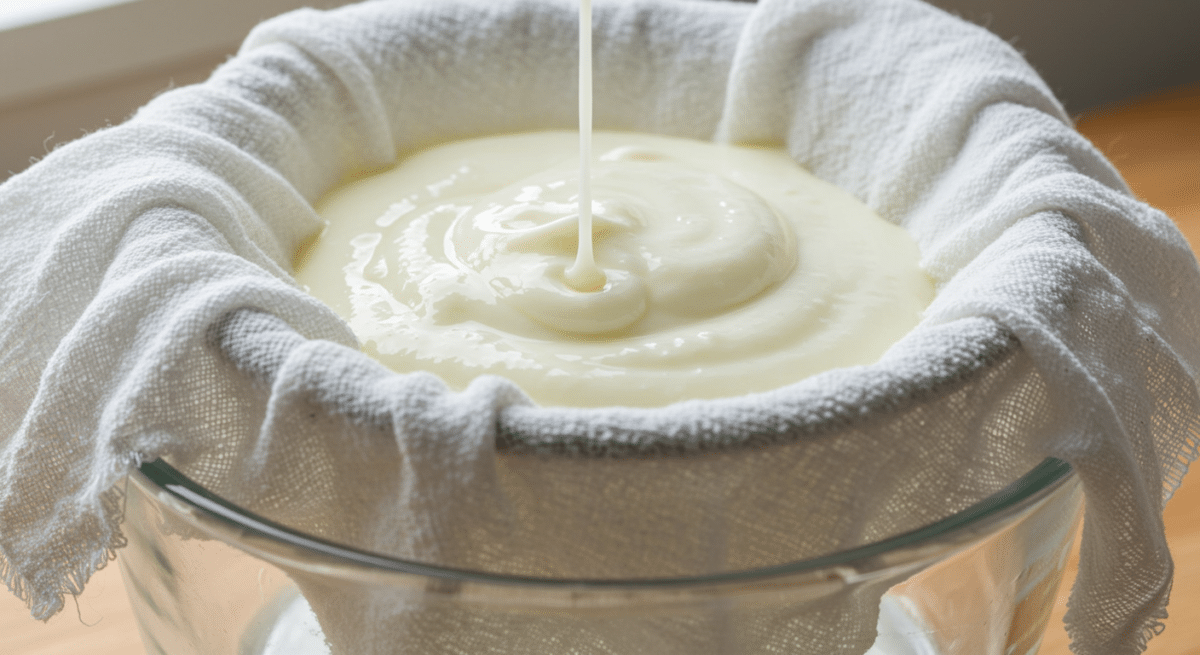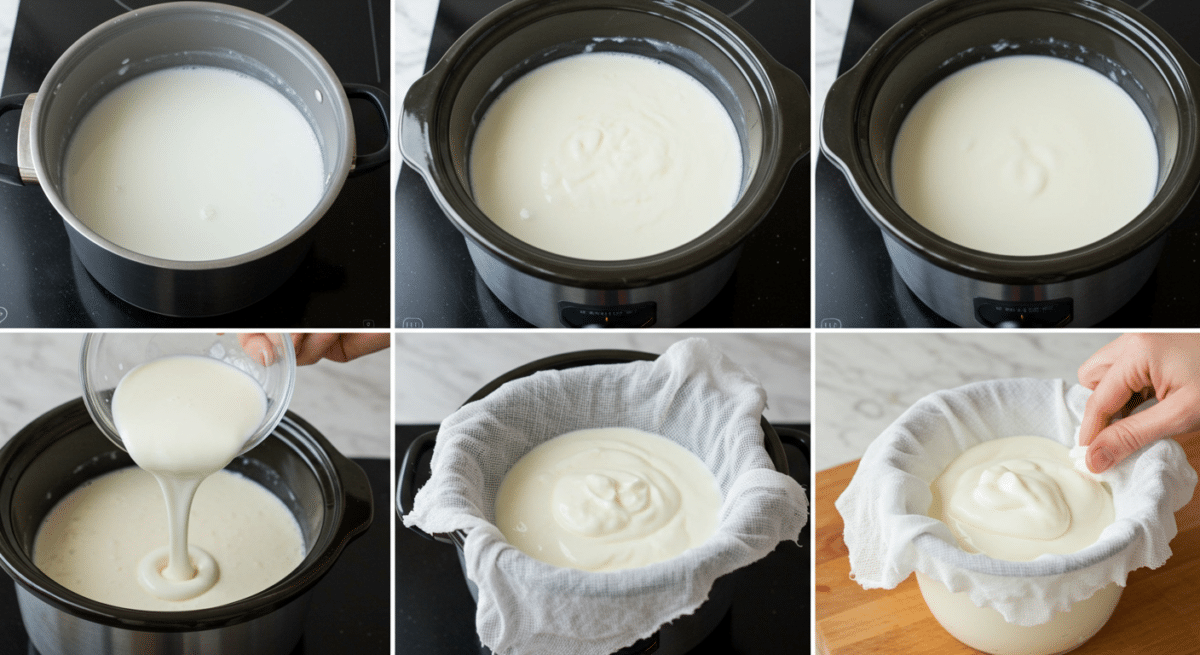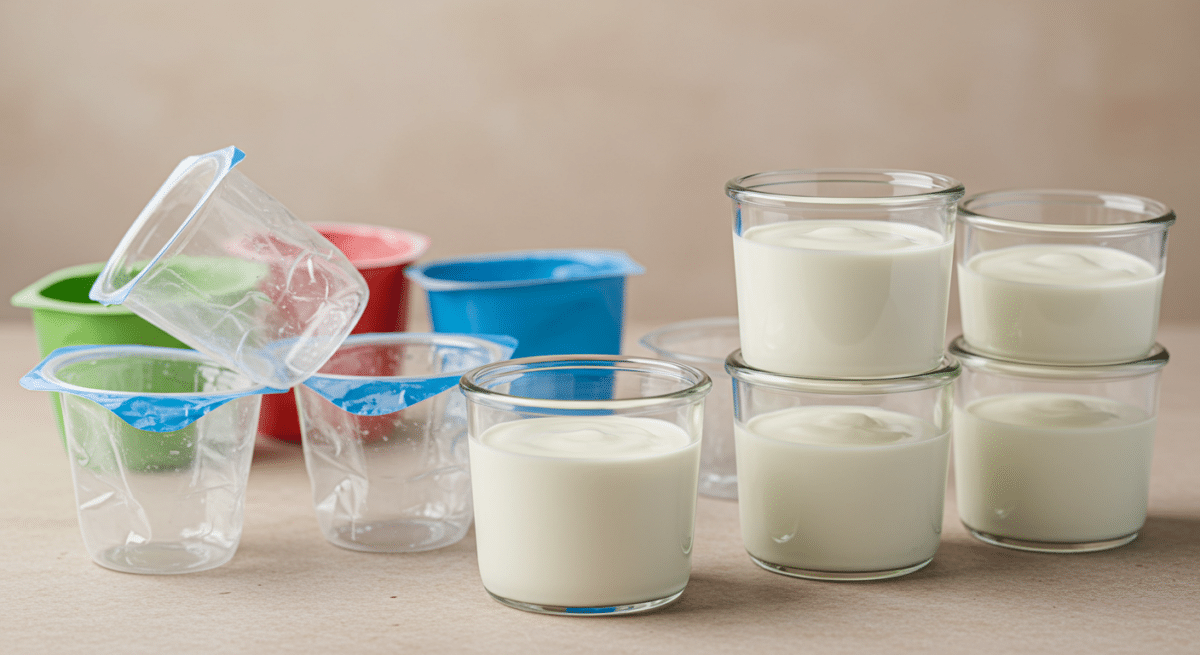Homemade Greek Yogurt vs. Store-Bought—a common debate that stirs up interest among health-conscious eaters, foodies, and budget-savvy consumers alike. Whether you’re searching for better nutrition, superior taste, or simply aiming to cut costs, deciding between homemade and store-bought Greek yogurt can feel overwhelming.
In this guide, we dive deep into everything you need to know about these two options. We’ll compare nutritional value, cost, convenience, taste, customization potential, and even environmental impact. If you’re wondering whether whipping up a batch at home is worth your time or if grabbing a tub off the shelf is the smarter move, we’ve got you covered.
Discover great ideas like the health benefits of Greek yogurt to complement this guide.
Let’s explore every angle so you can make the best choice for your body, wallet, and lifestyle.
PART 1: Nutritional Comparison – Homemade vs. Store-Bought Greek Yogurt
Protein Content and Quality

When comparing Homemade Greek Yogurt vs. Store-Bought, protein is often the star of the show. Greek yogurt, by design, has more protein than regular yogurt due to the straining process. But does homemade yogurt match the protein levels of commercial brands?
Homemade Greek yogurt allows complete control over the milk-to-yogurt ratio, meaning you can strain it to achieve your desired thickness and protein density. Some people even double-strain their yogurt for a higher protein snack. However, you won’t always know the precise protein count unless you calculate it manually based on the milk used.
In contrast, store-bought Greek yogurt clearly displays protein grams per serving on its label. Brands like Chobani, FAGE, or Oikos offer between 15g to 20g per serving thanks to industrial straining and standardization. If you’re focused on consistency and tracking macros, store-bought options offer peace of mind.
Bottom Line: Homemade can be just as protein-rich—if not more—but it requires attention to detail and proper technique.
Don’t miss our Greek yogurt parfait with honey and nuts for a protein-packed treat idea.
Additives, Preservatives, and Sugar Levels
One major reason people lean toward homemade dairy options is to avoid unnecessary additives. When making yogurt at home, you choose every ingredient—no stabilizers, flavorings, or artificial sugars unless you add them yourself.
On the other hand, store-bought Greek yogurt—especially flavored varieties—often includes thickeners like pectin or gelatin, preservatives for shelf life, and a surprising amount of sugar. Even some “low-fat” or “light” yogurts sneak in artificial sweeteners and gums to enhance taste and texture.
Here’s a quick look at common ingredients found in flavored store-bought vs. homemade:
| Ingredient | Homemade Greek Yogurt | Store-Bought Greek Yogurt |
|---|---|---|
| Whole Milk | ✅ | ✅ |
| Live Cultures | ✅ | ✅ |
| Added Sugar | ❌ | ✅ |
| Natural Flavoring | Optional | ✅ |
| Preservatives/Thickeners | ❌ | ✅ |
By going DIY, you’re not just cutting down on sugar—you’re ditching the junk. It’s ideal for those pursuing a clean-eating lifestyle.
Check out egg cupcakes with yogurt to see how homemade yogurt fits seamlessly into balanced meals.
Table of contents
- PART 1: Nutritional Comparison – Homemade vs. Store-Bought Greek Yogurt
- PART 2: Taste and Texture – Homemade Greek Yogurt vs. Store-Bought
- PART 3: Cost Comparison – Is Making Greek Yogurt at Home Cheaper?
- PART 4: Convenience and Time – Is It Worth Making Greek Yogurt at Home?
- PART 5: Customization – The Power of Personalization in Homemade Yogurt
- PART 6: Health Impact – Probiotics, Digestion, and Gut Health
- PART 7: Environmental Impact – Sustainability and Waste
- PART 8: Shelf Life and Food Safety – How Long Does Each Last?
- PART 9: Final Verdict – Which Greek Yogurt Option Should You Choose?
- Frequently Asked Questions – Homemade Greek Yogurt vs. Store-Bought
- Conclusion: Homemade or Store-Bought—Which Yogurt Wins?
PART 2: Taste and Texture – Homemade Greek Yogurt vs. Store-Bought
Texture Differences Between Homemade and Commercial Yogurt
When it comes to texture, the Homemade Greek Yogurt vs. Store-Bought debate gets especially interesting. Homemade Greek yogurt typically has a more rustic, uneven texture unless it’s double-strained or whipped. This “natural yogurt” texture appeals to many who enjoy its authenticity and thicker spoon-feel.
In contrast, store-bought Greek yogurt often boasts a silky-smooth, ultra-consistent texture. That’s largely due to commercial machinery and added thickeners like pectin, gelatin, or corn starch. These additives give pre-packaged yogurt its creaminess and long shelf life.
Here’s a quick visual breakdown:
| Texture Element | Homemade Greek Yogurt | Store-Bought Greek Yogurt |
|---|---|---|
| Thickness control | ✅ (you control it) | ✅ (standardized) |
| Creamy consistency | Depends on method | ✅ |
| Use of thickeners | ❌ | ✅ |
| Customizable feel | ✅ | ❌ |
So, if you’re after yogurt that feels fresh and tailored, homemade yogurt delivers a satisfying bite. But if smoothness matters most, store-bought yogurt takes the lead.
Discover great ideas like creamy yogurt scrambled eggs for recipes where texture really matters.
Flavor Control and Freshness
Let’s talk flavor. One major advantage of making your own Greek yogurt is total control over taste. Whether you prefer it tangy, mild, or somewhere in between, DIY yogurt can be tweaked to match your preference just by adjusting fermentation time.
Store-bought Greek yogurt, on the other hand, is created for mass appeal. Most brands lean toward a milder tang and neutral base to pair well with sweeteners or fruit additives.
What’s more, homemade yogurt is always fresh. You know exactly when it was made and what’s in it—no wondering about expiration dates or hidden sugars.
And if you enjoy exploring flavor combos? You’ll love how easy it is to infuse homemade yogurt with vanilla, cinnamon, or even herbs.
Looking for inspiration? Try Greek yogurt pumpkin bread to experiment with custom flavors.
PART 3: Cost Comparison – Is Making Greek Yogurt at Home Cheaper?
Breaking Down the Cost of Homemade Greek Yogurt
When comparing Homemade Greek Yogurt vs. Store-Bought, cost is a deal-breaker for many. If you eat yogurt regularly, those tubs from the grocery store can add up fast. Making yogurt at home might seem like a big task, but the savings speak for themselves.
To make homemade Greek yogurt, you only need two ingredients: milk and starter cultures (usually a spoonful of yogurt from a previous batch or store-bought plain yogurt). The cost per batch significantly drops as you reuse your starter.
Let’s do a simple breakdown for 1 quart of Greek yogurt:
| Ingredient/Item | Homemade Greek Yogurt | Store-Bought Greek Yogurt |
|---|---|---|
| 1 qt whole milk | ~$1.20 | — |
| Starter yogurt | ~$0.30 or reused | — |
| Total cost (1 quart) | ~$1.50 | $4.00–$6.00 |
As shown, the homemade option is more affordable in the long run—especially if you make large batches. Also, there’s no extra cost for packaging, branding, or transport.
Don’t miss our scrambled eggs with yogurt as a smart, low-cost recipe that pairs well with homemade yogurt.
Hidden Costs of Store-Bought Yogurt
Store-bought Greek yogurt seems convenient, but that convenience comes at a price—literally. Beyond the sticker price, there are hidden costs:
- Plastic containers contribute to waste and are rarely reused.
- Marketing markups often inflate prices, especially for “organic” or “high-protein” claims.
- Flavor additions like fruit-on-the-bottom or honey swirls hike the cost per ounce.
Also, pre-packaged yogurt limits you to what’s on the shelf. You pay extra for convenience and lose out on customization.
Check out health benefits of Greek yogurt to understand how budget-friendly eating can still be nutrient-dense.
Cost Efficiency Summary
In the long term, making yogurt at home wins the budget battle. Whether you’re cooking for a family or meal prepping for the week, DIY yogurt offers more bang for your buck. Plus, you get the freedom to flavor and portion your yogurt however you like.
Discover great ideas like Greek yogurt parfait with honey and nuts for cost-effective snacking at home.
PART 4: Convenience and Time – Is It Worth Making Greek Yogurt at Home?
Time Investment for Homemade Greek Yogurt

In the comparison of Homemade Greek Yogurt vs. Store-Bought, time commitment is often a deal-breaker. Homemade Greek yogurt isn’t necessarily difficult to make—but it does take time and patience.
The typical DIY process involves heating milk, cooling it to a specific temperature, adding a live culture, then incubating it for 6–12 hours. After fermentation, you’ll need to strain the yogurt for a few more hours to achieve that signature thick texture. In total, you’re looking at a 12–18 hour turnaround—though most of that time is hands-off.
Still, for many, this slow-cooking ritual becomes a satisfying weekly routine.
Discover great ideas like Greek yogurt pumpkin bread if you want to make use of large homemade batches.
Grab-and-Go Benefits of Store-Bought Yogurt
When speed matters, store-bought Greek yogurt wins. No waiting, no mess, no prep—just grab, peel, and eat. Especially for busy mornings, school lunches, or on-the-go snacking, the convenience of pre-packaged yogurt can’t be beaten.
Plus, store-bought options come in single-serving sizes with pre-added fruit or flavoring, saving you time on mix-ins or meal prep.
However, this ease comes at a cost—both financially and nutritionally. You sacrifice freshness, flavor control, and often take in extra sugar or preservatives for that convenience.
Don’t miss our egg cupcakes with yogurt—a quick breakfast made with homemade yogurt for busy mornings.
PART 5: Customization – The Power of Personalization in Homemade Yogurt
Flavor Control and Add-Ins
If there’s one big perk to homemade yogurt, it’s customization. With homemade Greek yogurt, you decide everything—from milk type to culture strength to flavor. Want to make it with almond or goat milk? Prefer it extra tangy? Craving cinnamon-vanilla or berry swirl? You’re in charge.
You can infuse your yogurt with fresh fruit purées, raw honey, or even savory herbs. There’s no limit when it comes to crafting your ideal flavor profile.
On the flip side, store-bought Greek yogurt has limited varieties. You’re stuck with what the brand offers, which often includes too much sugar, artificial flavors, or a one-size-fits-all tang.
Looking for inspiration? Try scrambled eggs with yogurt with added herbs—a savory twist you can only truly nail with homemade yogurt.
Dietary Needs and Ingredient Control
Customization also means better control over dietary restrictions. Those following keto, paleo, vegetarian, or lactose-free diets find homemade yogurt more adaptable. You choose low-fat, full-fat, or non-dairy milk; you avoid unwanted additives and hidden sugars.
Pre-packaged yogurt, by contrast, often contains ingredients that don’t align with special diets. Even “healthy” options can surprise you with emulsifiers, milk powder, or “natural flavors” that aren’t so natural.
Check out creamy yogurt scrambled eggs to explore how homemade yogurt works across various dietary needs.
PART 6: Health Impact – Probiotics, Digestion, and Gut Health
Probiotic Content in Homemade vs. Store-Bought Greek Yogurt
One of the major health perks in the Homemade Greek Yogurt vs. Store-Bought comparison lies in probiotics. These live bacteria support gut health, immunity, and even mood regulation. But where are they more abundant?
Homemade Greek yogurt generally contains a broader range of active cultures, especially if you use a high-quality starter. Since the yogurt isn’t heat-treated after fermentation (unlike some store-bought brands), more beneficial bacteria survive.
In contrast, store-bought Greek yogurt may undergo pasteurization post-fermentation, which can reduce probiotic viability. While many reputable brands add probiotics back in, not all do—and some offer only one or two strains.
Here’s a comparison:
| Probiotic Factor | Homemade Yogurt | Store-Bought Yogurt |
|---|---|---|
| Variety of strains | ✅ Often higher | ❌ Often limited |
| Post-processing heat | ❌ None | ✅ Sometimes |
| Additives or sugar | ❌ None | ✅ Often added |
Check out health benefits of Greek yogurt to explore how probiotics impact your daily wellness.
Digestive Benefits and Lactose Sensitivity
Another win for DIY yogurt? It’s easier on digestion. Homemade Greek yogurt often has less lactose due to the extended fermentation and straining process, making it more tolerable for people with mild lactose intolerance.
Additionally, the absence of gums and additives (often found in store-bought varieties) means fewer chances of bloating or stomach discomfort.
If gut health is your focus, homemade options often lead to better digestive outcomes thanks to pure ingredients and more live cultures.
Don’t miss our Greek yogurt parfait with honey and nuts—a wholesome way to fuel your gut.
PART 7: Environmental Impact – Sustainability and Waste
Packaging and Plastic Waste

From an environmental standpoint, Homemade Greek Yogurt vs. Store-Bought has a clear winner. Making yogurt at home eliminates single-use plastic containers, which are a major waste concern with pre-packaged yogurt.
Store-bought brands often rely on plastic tubs or foil-sealed cups, contributing to landfill overload and pollution. Even if recyclable, these materials often don’t get properly processed.
Homemade yogurt, by contrast, uses reusable jars or glass containers, drastically reducing your carbon footprint.
Energy Usage and Transportation
Store-bought Greek yogurt is mass-produced, packaged, and shipped long distances—adding to carbon emissions. From refrigeration trucks to shelf storage, the process burns energy.
In contrast, homemade yogurt requires no transport, minimal electricity (a stovetop and maybe an Instant Pot), and no wasteful packaging. It’s a small but meaningful step toward eco-friendly eating.
Looking for inspiration? Try Greek yogurt pumpkin bread—a sustainable recipe when made with homemade yogurt.
PART 8: Shelf Life and Food Safety – How Long Does Each Last?
How Long Does Homemade Greek Yogurt Last?
In the ongoing debate of Homemade Greek Yogurt vs. Store-Bought, shelf life is another factor worth weighing. Homemade Greek yogurt typically stays fresh for about 7 to 10 days in the refrigerator when stored in a sealed glass container.
Since it’s free from commercial preservatives, homemade yogurt doesn’t last as long. However, this shorter shelf life often translates to fewer additives and fresher consumption, which many find to be a health benefit, not a drawback.
Here are key storage tips:
- Always store in airtight containers
- Keep it refrigerated below 40°F
- Avoid double-dipping to maintain hygiene
Store-Bought Yogurt: Expiration and Additives
Store-bought Greek yogurt usually boasts a longer shelf life, lasting 2 to 3 weeks or more past its production date. This is thanks to added stabilizers and preservatives that extend freshness and maintain texture.
But with longer shelf life comes trade-offs. These yogurts are typically processed and may contain chemical additives to stay “fresh” longer—often at the cost of taste and purity.
Additionally, some store-bought options include pasteurized live cultures, reducing probiotic impact over time.
Don’t miss our egg cupcakes with yogurt—a delicious way to use your homemade batch before it expires.
PART 9: Final Verdict – Which Greek Yogurt Option Should You Choose?
Homemade vs. Store-Bought: Which One Is Better for You?
After breaking down every aspect of the Homemade Greek Yogurt vs. Store-Bought debate, here’s the truth: both options have benefits, and the best choice depends on your lifestyle, budget, and health goals.
| Criteria | Homemade Yogurt | Store-Bought Yogurt |
|---|---|---|
| Nutrition | High (customizable) | Standardized but may include additives |
| Flavor & Texture | Fully customizable | Consistent but less control |
| Cost | Lower long-term | Higher per-serving cost |
| Convenience | Time-intensive | Quick and easy |
| Shelf Life | 7–10 days | 2–3 weeks |
| Sustainability | Eco-friendly (less plastic) | Higher environmental impact |
If you’re focused on clean eating, saving money, and reducing waste, homemade is the clear winner. But if you’re in a time crunch and prioritize convenience, store-bought yogurt fits the bill.
Frequently Asked Questions – Homemade Greek Yogurt vs. Store-Bought
Yes, in many ways. Homemade Greek yogurt typically contains no preservatives, artificial thickeners, or added sugars. You control the ingredients, allowing for a more natural and nutrient-dense result—especially beneficial for clean eaters or those with dietary restrictions.
Absolutely. While it takes time, the benefits of cost savings, full customization, and reduced environmental impact often outweigh the minor inconvenience. Plus, homemade yogurt delivers fresher taste and a higher probiotic count when made properly.
Homemade yogurt generally comes out on top in terms of nutritional purity. Without additives or flavor enhancers, it’s a cleaner, more authentic product. Store-bought options may still offer solid protein content, but they’re often less transparent.
Yes, and sometimes even more—depending on how long it’s strained. The protein content in homemade Greek yogurt depends on the milk used and the straining time. Double-straining can yield a denser, protein-rich yogurt comparable to top commercial brands.
Conclusion: Homemade or Store-Bought—Which Yogurt Wins?
In the ultimate showdown of Homemade Greek Yogurt vs. Store-Bought, your choice comes down to what matters most to you. If you crave control over ingredients, better nutrition, and eco-conscious habits, homemade yogurt is the winner. If you need speed, consistency, and convenience, store-bought options are still a solid choice.
No matter your decision, both options can support a healthy lifestyle.
Looking for more recipe inspiration, food comparisons, and clean-eating ideas?
👉 Follow us on Pinterest — just search for @cuisinecrafted on the app or click here to explore our boards packed with yogurt recipes, Mediterranean meals, and creative kitchen tips.
Learn more about the health benefits of Greek yogurt and start crafting your ideal yogurt experience today.
PrintHomemade Greek Yogurt
A step-by-step guide to making thick, protein-rich homemade Greek yogurt using just milk and a starter culture. Perfect for clean eating, meal prep, and gut health.
- Prep Time: 10 minutes
- Cook Time: 8 hours
- Total Time: 8 hours 10 minutes
- Yield: 4 people 1x
- Category: Breakfast, Snack
- Cuisine: Mediterranean, American, Healthy
Ingredients
- 1 liter Whole milk Organic or grass-fed preferred
- 2 tbsp Plain yogurt Must contain live active cultures
Instructions
homemade Greek yogurt
- Heat the Milk: Pour the milk into a saucepan and heat over medium flame until it reaches 180°F (82°C). Stir occasionally to avoid scorching.
- Cool the Milk: Remove from heat and allow to cool to 110°F (43°C). You can place the pot in a cold water bath to speed up the process.
- Add the Starter: Stir in the plain yogurt (starter) and whisk gently until well combined.
- Ferment the Yogurt: Pour the mixture into a covered container or Instant Pot. Incubate at 105–110°F (40–43°C) for 8–12 hours without disturbing.
- Strain the Yogurt: Place cheesecloth over a sieve and set it on top of a mixing bowl. Pour the yogurt into the cloth and strain for 2–4 hours to achieve Greek-style thickness.
- Store and Enjoy: Transfer the thickened yogurt into clean glass jars. Store in the refrigerator for up to 10 days.
Notes
Calories: 120 kcal
Protein: 11g
Carbohydrates: 7g
Fat: 6g
Sugar: 5g
Calcium: 20% DV
Probiotics: High (strain-dependent)
Nutrition
- Calories: 120


1 thought on “Homemade Greek Yogurt vs. Store-Bought: Which is Better?”